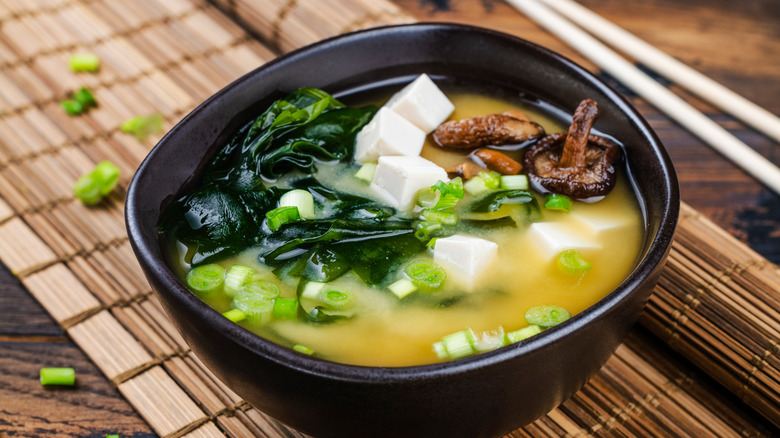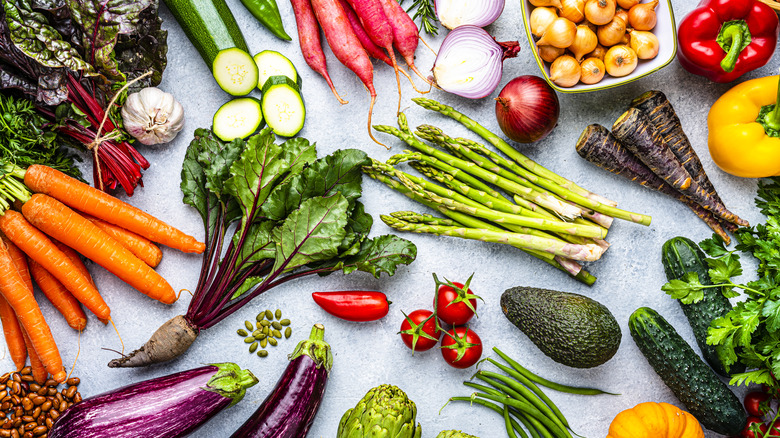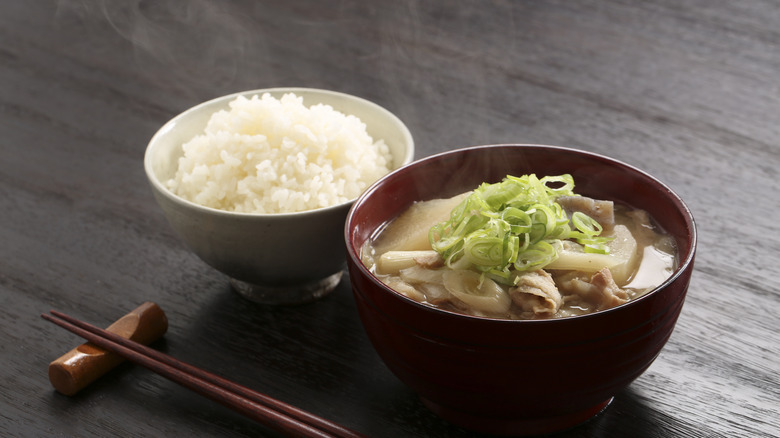The Best Way To Prepare Vegetables For Next Level Miso Soup
If you have been to a Japanese restaurant, you have most certainly encountered a bowl of miso soup. Served with almost every meal in Japan, it is a warm and comforting broth of dashi — a kind of Japanese stock — and miso, a fermented soybean paste. Both are foundational ingredients of traditional Japanese cuisine and when combined, it produces one of the best soups on earth.
Usually, miso soup is served with nothing more than several cubes of soft tofu and some seaweed strips, and it is a warm and savory start to a Japanese meal. However, like many dishes in Japanese cuisine, the humble miso soup is a blank canvas on which you can add more ingredients to turn it into something hearty and suitable for a light meal. Aside from the usual suspects of tofu and seaweed, you can add other fresh vegetables to make the soup more substantial. Since there is plenty of flavor in the broth, there is absolutely no reason to sauté the vegetables before cooking, as it would leave an unappetizing film of oil on top of your soup.
Perfect vegetables for miso soup
To make a vegetable miso soup, start with a dashi broth. While commercial dashi bases are available in powdered form in specialty grocery stores and online, making your own is not difficult. First, simmer dried kombu seaweed in water for 20 minutes. Next, remove the seaweed and add dried shiitake mushrooms and simmer for 30 minutes more. The result is a light, savory soup base — a kombu-mushroom dashi that is suitable for vegetarian and vegan use. Once the dashi is ready, remove the now-rehydrated shiitake mushrooms, cut them into slices, and add them back to the broth.
While the dashi is simmering, prepare the vegetables for cooking. Some of the more traditional vegetables to use for miso soup include leeks, mushrooms, bamboo shoots, and daikon radishes. However, any vegetable that cooks well by poaching is suitable, such as tomatoes, carrots, or snow pea pods. Simply cut the vegetables into a size that would cook evenly, and you are ready to proceed. Ingredients that would take longer to cook, such as carrots, should be sliced into thin slices or matchsticks, while vegetables that cook quickly can be added to the broth as is. Once cut to the appropriate size, add the vegetables to the simmering broth and cook until done. Be careful not to boil the dashi, as it can make it bitter.
Choosing the right miso
After you have your vegetables sorted, it's time to add miso. It sounds simple enough, but there are actually a few varieties to choose from that will affect the flavor of your soup. Outside of Japan, you will most likely encounter 3 kinds of miso: red, white, and light (yellow). Red miso is aged the longest, and it has the strongest flavor. On the opposite spectrum, white miso is aged only for a short time, producing a less salty and more delicate taste. Light or yellow miso is produced in a similar manner as white miso, but more salt is added. The most common variety to use for miso soup is white or yellow miso, but red miso can be added sparingly into the mix for a stronger flavor.
To add miso to your soup, put a heaping spoonful of miso in a ladle. Remove the soup from heat and carefully submerge the ladle containing miso into the broth just below the surface. With a small whisk, break up the miso paste and mix it into the broth while keeping the paste within the ladle until all of it is dissolved. Taste the broth, and if more miso is needed, repeat the ladle and whisk process with more miso paste. Once you are satisfied with the taste, your vegetable miso soup is ready to serve. Garnish each portion with dried seaweed and sliced scallions and serve it alongside a bowl of rice for a substantial meal.



